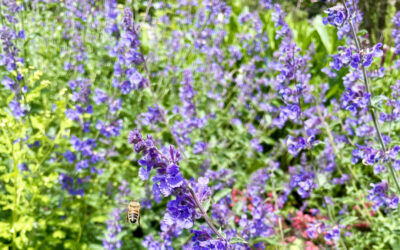Gardening with Nature
Article by Sigrie Kendrick
Can we make better choices?
Next to our vital agricultural industry, outdoor landscapes in the Okanagan suck up the most
water.
And there’s no comparison when you consider which use is the most important: we can no
more do without food than we can do without water.
Unfortunately, the Okanagan is a near-desert and water is in short supply, a situation made
much worse by climate change and the resulting extremes in weather such as drought.
While attitudes are changing, wholesale buy-in from civic authorities, the development
community, landscape professionals and nurseries, as well as those of us who plant and water
our gardens and outdoor living spaces is absolutely essential.
No longer can we afford to be so irresponsible as to use plants that require large quantities of
water to stay alive.

With that in mind, the Okanagan Xeriscape Association has joined forces with the Okanagan
Basin Water Board, an entity on which every taxpayer in the region has representation, and its
Okanagan WaterWise program to help educate the whole community about the importance of
replacing water-thirsty landscapes with beautiful ones that require far less water.
When we obliterate natural landscapes to create buildings, and pave our grasslands and forests
over with concrete and asphalt, we simply must re-plant at least some of that with native-type
plants which don’t require large quantities of water to stay alive.
Rewilding
When we obliterate natural landscapes to create buildings and pave our grasslands and forests
over with concrete and asphalt, we simply must re-plant at least some of that with native-type
plants which don’t require large quantities of water to stay alive.
Re-wilding is the term for restoring healthy ecosystems in the landscape that have been
disturbed by humans. Think of the millions of acres of mono-culture that is turf grass currently
planted across this country.
Re-wilding aims to reverse biodiversity loss by using native plants and animal life to rebuild
ecosystems and mitigate climate change.
It is in the hope that we as humans can undo some of the destruction we have wreaked on our
home—earth.
Please consider allocating a portion of your garden to native plants.
Plants native to the Okanagan thrive in our semi-arid valley and support countless pollinators,
birds, and animals. Think of the ripple effect, much as that from a single stone thrown into a
pond.

It’s simplistic to believe that because the bottom of our Okanagan Valley features a sparkling
blue lake, water is not scarce. As soon as we begin to ‘mine’ the lake— use more water than is
replaced by natural precipitation each year— we are in big trouble.
The alternative is for all of us to wake up and give our heads a shake; to enact legislation
requiring that new developments install landscapes that use the principles of xeriscape; to insist
as creators of subdivisions, as home builders and homeowners that our landscapes use
drought-tolerant plants instead of lawn grasses, trees, shrubs and flowers that belong in a
coastal rainforest.
We have to move away from inappropriate landscape choices such as turf grass, cedar hedges
and inappropriate plant selections and instead move toward choices that better mimic our
stunning natural Okanagan environment and support our pollinators, birds, and small mammals.
We humans have to relinquish our control issues and let nature do what she does best— heal.
Sigrie Kendrick is a Master Gardener and Executive-Director of the Okanagan Xeriscape Association. She can be reached at 778-363-8360 or by email at exec_dir@okanaganxeriscape.org.







0 Comments